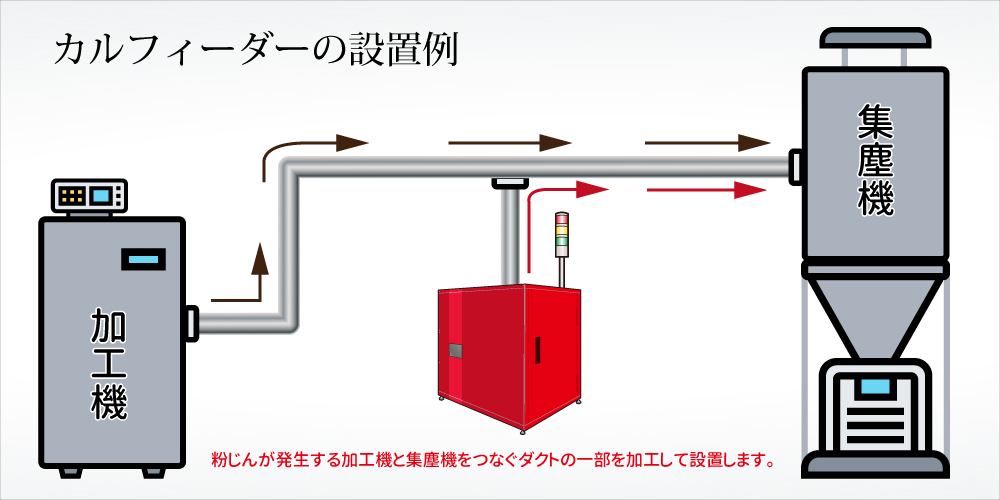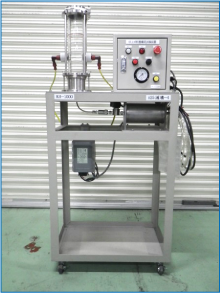
| Product name | CULFEEDER for aluminum AL | CULFEEDER for iron F |
|---|---|---|
| Machine picture |  |
 |
| Purpose | In order to prevent aluminum dust explosion, the appropriate feed rate of calcium carbonate is determined after verifying the dust suction conditions of the dust collector and the lower explosive limit of dust. It only operates when the dust collector is running, and the supply can be adjusted so that you can reduce waste (dust + calcium carbonate). | In order to prevent dust fires such as iron powder, the correct amount of calcium carbonate is determined after verifying the dust suction and ignition of the dust extractor. It only operates when the dust collector is running, and the supply can be adjusted so that you can reduce waste(dust + calcium carbonate). |
| Operation |
After the power switch is on, CULFEEDER is activated when it detects dust collector wind(suction force). Once the supply volume has been determined in advance, it starts feeding the powder according to the operation of the dust collector. *Optional:Electrical retrofit is required if CULFEEDER is linked to the operation signal of the dust collector instead of the suction power. |
|
| Size *including signal tower |
W500mm×D525mm×H809mm *W500mm×D525mm×H1170mm |
|
| Calcium carbonate filled | 25kg(equivalent to 1 bag) | |
| Voltage | 100V | |
| Hazard determination test | Lower explosive limit measurement test | Small gas flame test |
| Main use cases | Die casting, Titanium processing, | Forging, peening, plastic |
| Adjust function of the amount of powder (Inverter) |
Standard(both continuous and intermittent supply are possible) | |
| Low powder amount warning (Level sensor) |
Standard(buzzer and signal tower warning when it lowers) | |
| Signal tower | Standard 3 stages | |
| Touch panel | Standard | Optional |
| Caster | Optional | |
| Remote notification function(Wi-Fi) | Optional | |
| Forced calcium carbonate supply in the event of a fire |
Optional | |
【Actual conditions】
Today we have a surprising number of dust collector fires. However, some fires that broke out in the factory (minor fires) seem to have been attempted to cover up instead of proper reporting.
The reality is certainly more than the numbers actually reported.
Fires are caused by dust catching some kind of fire in the dust collector. However, there are many cases of dangerous dust accumulating in the dust collector, causing a fire easily lit by a small flame, and once the dust is burned, it is difficult to be extinguished. If you try to get rid of the fire, the fire spark spills over the area.
【Countermeasures】
There are two main safety measures for dust collectors: Measures to be taken after a fire (fire suppression measures) and measures to be taken before a fire (fire prevention measures).
※Fire prevention systems
Calcium carbonate is supplied to the dust collector and mixed with the highly flammable dust to lessen the danger of fire.
※Fire suppression system
Non-flammable gas is injected or sprayed into the burned or high-temperature fire origin to shut off oxygen to extinguish a fire as a CO2 fire extinguishing system.
| Name of test | Lower explosive limit measurement test | Small gas flame test |  |
|---|---|---|---|
 |
Collecting dust that may cause explosion at your site. | Collecting dust that may cause explosion at your site. | |
 |
Conducting interview surveys with customers about the situation where dust is generated. | Conducting interview surveys with customers about the situation where dust is generated. | |
 |
Determining the appropriate feed rate of calcium carbonate after conducting lower explosive limit measurement. | Determining the appropriate feed rate of calcium carbonate after conducting ignition risk measurement. | |
 |
Setting up a supply outlet in the pipe to the dust collector at customer's site. (Note 1) | Setting up a supply outlet in the pipe to the dust collector at customer's site. (Note 1) | |
 |
Installing CULFEEDER. | Installing CULFEEDER. |
| Lower explosive limit test | Small gas flame test | ||||||||||||||||
|---|---|---|---|---|---|---|---|---|---|---|---|---|---|---|---|---|---|

|

|
||||||||||||||||
|
Mixing non-combustible material with dust and set sparks to check the presence or absence of explosion.
|
Exposing the test sample to the flame for 10 seconds to measure ignition time.
|
||||||||||||||||
|
【Judgment by the test】
“Measuring the risk of explosion from the viewpoint of the concentration" of dust containing flammable dust such as aluminum. The results are used to determine the mixing amount of calcium carbonate or other substances fed from CULFEEDER.
|
【Judgment by the test】
“Measuring what the level of flammability from the viewpoint of the ignition state” of dust which is mixed with iron powder or other substances. The results are used to determine the mixing amount of calcium carbonate or other substances fed from CULFEEDER.
|
||||||||||||||||
|
【Test method】
|
【Test method】
|